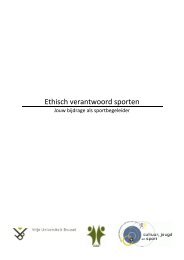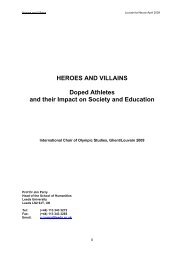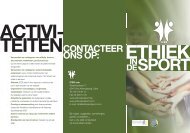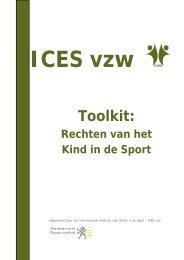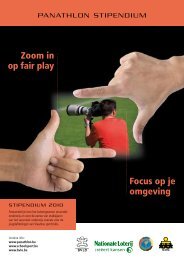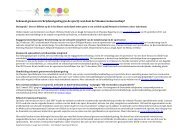Part 3 GLOBAL ISSUES: HARASSMENT AND ABUSE RESEARCH
Part 3 GLOBAL ISSUES: HARASSMENT AND ABUSE RESEARCH
Part 3 GLOBAL ISSUES: HARASSMENT AND ABUSE RESEARCH
Create successful ePaper yourself
Turn your PDF publications into a flip-book with our unique Google optimized e-Paper software.
Whilst 8% of sports clubs knew of sexual abuse cases, and more than 9 out of<br />
10 agreed that the prevention of sexual abuse was the most important prevention<br />
field in sport, it may appear paradoxical that only 15% of these clubs had written<br />
guidelines for coaches. This incongruence between attitudes and actions may<br />
indicate that many sport clubs avoid child protection initiatives due to complacency<br />
and ignorance about abuse dynamics. The fact that than 70% of the responding clubs<br />
had informal norms about interpersonal behaviour and only 60% said they had<br />
discussed such norms may indicate that sport clubs prefer to have informal<br />
agreements rather than written regulations and to leave things unsaid, thinking such<br />
measures are unnecessary or even expressions of distrust. There were remarkable<br />
differences between the clubs that had had previous cases and those that had not,<br />
with the former being twice as likely to have written guidelines and three times as<br />
likely to have written procedures for case handling.<br />
The reported results replicate the past findings by Brackenridge in a smaller<br />
English sample, which indicates that results can be generalised to other countries or<br />
at least serve as some kind of benchmark. Since this study was completed it has<br />
become compulsory for all sectors of Danish society where adults are working with<br />
children to obtain a criminal record check for all new staff. This legislation has been<br />
approved and recommended by the national governing bodies of sport and today the<br />
majority of clubs comply with this procedure opposed to less than 5% in 2003. This<br />
may reinforce the need for sports organisations to make clear child protection policies<br />
in order to guide youth sports clubs whose members generally have little knowledge<br />
about how to develop effective child protection measures. It appears to be unfair that<br />
children should pay the price of adult vanity and complacency: this research<br />
underlines that all parts of organised sport have an important role to play for<br />
developing safe and healthy sport environments.<br />
Notes<br />
1. Fasting, K., Brackenridge, C.H. and Walseth, K., ‘Consequences of sexual harassment in sport for<br />
female athletes’, in C.H. Brackenridge and K. Fasting., (Eds.) Sexual harassment and abuse in sport:<br />
International research and policy perspectives, Journal of Sexual Aggression, 2002, 8, 2, pp.37-48.<br />
2. Brackenridge, C.H., Spoilsports: Understanding and preventing sexual exploitation in sport, 2001,<br />
pp. 135-145.<br />
3. Brackenridge, C.H., ‘“… so what?” Attitudes of the voluntary sector towards child protection in sports<br />
clubs, Managing Leisure, 2001, 7, 2, pp. 103-124.<br />
45



